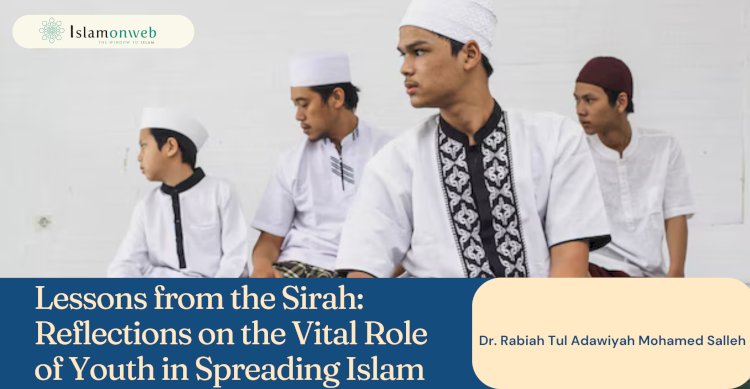Lessons from the Sirah: Reflections on the Vital Role of Youth in Spreading Islam
Reading Yasir Qadhi’s The Sirah of The Prophet : A Contemporary and Original Analysis (2024) has deepened my understanding of the historical and social contexts of the Prophet Muhammad’s (ﷺ) life. This book offers a refreshing perspective that seamlessly bridges traditional narratives with modern insights. Having read the Sirah since childhood, I found this analysis particularly impactful as it shed light on dimensions of the Sirah I had previously overlooked or not fully appreciated. While there is much to draw from the Sirah, in this article, I wish to highlight one significant insight that resonates deeply with me as an educator: the pivotal role youth played in the establishment of Islam, particularly during the formative years leading to the Prophet’s migration to Madinah.
Revisiting the Role of Youth in the Sirah
The narrative of Islam’s establishment often emphasises the Prophet’s (ﷺ) interactions with the elites of Quraysh and other influential tribes. However, Yasir Qadhi’s book sheds light on an often-overlooked truth: it was the youth who played a catalytic role in some of the most monumental moments in Islamic history. A striking example is the story of the six young men from Yathrib (later Madinah) who embraced Islam during the Hajj season in the eleventh year of Prophethood. Unlike the prominent elites the Prophet (ﷺ) initially approached, these young men were relatively obscure and unknown within their society. Yet, their extraordinary conviction and commitment marked the beginning of a transformative chapter in the history of Islam.
The First Covenant of Aqabah: A Youth-Driven Initiative
The six youths from Yathrib were not tribal leaders or individuals of high social standing. Rather, they were young men who, after hearing the Prophet’s (ﷺ) message, recognised its potential to address the deep divisions and conflicts plaguing their community. Their acceptance of Islam during that initial meeting with the Prophet (ﷺ) served as the precursor to The First Covenant of Aqabah. This covenant, though seemingly small, was a significant step that showcased the courage and clarity of youth who were willing to commit to a vision of unity and justice, despite the considerable risks involved.
It is important to note that the First Covenant of Aqabah involved twelve individuals from the tribes of Aws and Khazraj. At the time, these tribes represented the largest group of converts to Islam outside of Mecca. Their collective decision to pledge allegiance to the Prophet (ﷺ) was significant, marking the beginning of a broader acceptance of Islam in Yathrib. This defining moment set the stage for the eventual establishment of Madinah as the first Islamic state.
As an educator, this event resonates deeply with me. It is a powerful reminder of the transformative potential of youth when they are empowered with purpose and guided by principles. These individuals from Yathrib, untainted by entrenched interests or the conservative mindsets often associated with older generations, exemplified youthful idealism at its finest. Their ability to recognise the truth and act upon it paved the way for profound change and laid the foundation for the remarkable developments that followed.
The Second Covenant of Aqabah: Youth Leading the Way
Following the initial contact, the efforts initiated by the twelve individuals from the First Covenant of Aqabah bore fruit a year later when seventy-five people—seventy-three men and two women—from Yathrib pledged allegiance to the Prophet (ﷺ) in what is known as The Second Covenant of Aqabah. This covenant was far more comprehensive, involving commitments to protect the Prophet (ﷺ) and support his mission. Remarkably, many of those present were still young, demonstrating that the core strength of this emerging Muslim community lay in its youthful vigour and determination.
During the Second Covenant of Aqabah, the Prophet (ﷺ) was accompanied by his uncle, Al-‘Abbas ibn ‘Abdul-Muttalib, who at that time had not yet embraced Islam. Al-‘Abbas, concerned for his nephew’s safety, approached the situation from a tribal perspective and sought to assess the individuals present. He remarked to the Prophet (ﷺ), “O my nephew, I do not recognise any of these men.” This statement is profound in its implications. Al-‘Abbas, accustomed to interacting with tribal leaders and men of prominence, was searching for individuals of equal prestige and influence. However, he found none among the group. This highlights the seemingly obscure status of those who pledged allegiance— individuals who were largely unknown, but they were chosen by Allah and later became instrumental in establishing the first Islamic state.
The Second Covenant of Aqabah illustrates a crucial aspect of youth leadership: the capacity to inspire and mobilise others around a shared vision. The young believers from Yathrib played a key role in encouraging others to embrace Islam, effectively communicating the Prophet’s (ﷺ) message and demonstrating its transformative potential for their society. This event also emphasises the value of collaborative effort, where the passion and drive of youth are complemented by the guidance and experience of others, creating a powerful synergy that enables meaningful change.
Migration to Madinah: Youth as the Foundation of Change
The Prophet’s (ﷺ) eventual migration to Madinah was the culmination of these pivotal efforts. The role of youth in facilitating this migration and establishing the first Islamic state is undeniable. From providing logistical support to offering their homes and resources, the young Muslims of Madinah exhibited unparalleled dedication. Their courage and readiness to make sacrifices were essential in building a society that reflected the principles of justice, equality, and compassion taught by the Prophet (ﷺ).
As a lecturer, I see strong parallels between these historical events and the potential of today’s youth. In my interactions with students, I often observe their enthusiasm for change and their desire to contribute meaningfully to society. However, this potential requires thoughtful guidance—much like how the Prophet (ﷺ) mentored the young believers of his time. By imparting knowledge, instilling confidence, and encouraging critical thinking, educators can play an important role in shaping a generation that continues to uphold and carry forward the values of Islam in a contemporary context.
Lessons for Our Times
Reflecting on these events, I see several meaningful lessons that hold great relevance for today’s Muslim youth and for those of us responsible for guiding them:
- Recognising the Power of Youth
The story of the six young men from Yathrib and the ensuing Aqabah covenants demonstrate that age is no obstacle to making significant contributions. Young people possess the energy, creativity, and courage required to tackle societal challenges. They must be equipped with the principles and opportunities to lead and make impactful decisions.
- Guidance and Mentorship
Just as the Prophet (ﷺ) provided guidance to the youth around him, today’s leaders, educators, and mentors bear the responsibility of nurturing the potential of young individuals. This involves strengthening their understanding of Islamic principles and cultivating their ability to think critically about the Sirah’s application in contemporary contexts.
- Collaboration Across Generations
The early success of Islam was partially due to the collaboration between the energy and enthusiasm of youth and the wisdom and experience of the older generations. This balance remains essential for achieving meaningful change.
- Commitment to Principles
The youth of Yathrib stood firm in their commitment to the values of Islam, undeterred by societal pressures. Their unwavering dedication serves as a powerful inspiration for today’s youth to remain steadfast in their beliefs, even when faced with challenges.
- Leveraging Social Media for Good
With today’s interconnectedness, youth have an unprecedented opportunity to build inclusive communities through social media. By promoting Islamic values, justice, and positive engagement, they can address societal challenges and inculcate unity.
Bridging the Past and Present
Yasir Qadhi’s book has helped me view the Sirah not just as a historical account but as a source of timeless lessons that remain deeply relevant today. The role of youth in the establishment of Islam stands out, especially in today’s world, where young people are often at the forefront of social and political movements. By studying the Sirah, we can draw inspirations from the example of the Prophet (ﷺ) and the early Muslims, learning how their values and strategies can be applied to address the challenges we face in modern times.
As an educator, I strive to share these lessons with my students, encouraging them to see themselves as part of an impactful legacy. The story of the six youths from Yathrib and their key role in the establishment of Islam is a powerful reminder of the potential within each individual to create meaningful change. My hope is that reflecting on these stories will inspire a new generation to contribute to society with the same dedication and commitment that characterised the early Muslims.
About the author:
Rabiah Tul Adawiyah Mohamed Salleh, PhD, is Assistant Professor in Linguistics at the Department of English Language and Literature, AbdulHamid AbuSulayman Kulliyyah of Islamic Revealed Knowledge and Human Sciences (AHAS KIRKHS), International Islamic University Malaysia. She teaches Psycholinguistics at the undergraduate and postgraduate levels. Her research focuses on children, youth, and the decolonisation and Islamisation of knowledge, emphasising the integration of Islamic principles and local contexts into academic discourse.
Disclaimer
The views expressed in this article are the author’s own and do not necessarily mirror Islamonweb’s editorial stance.
























Leave A Comment